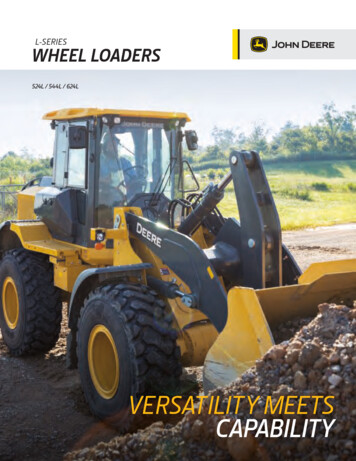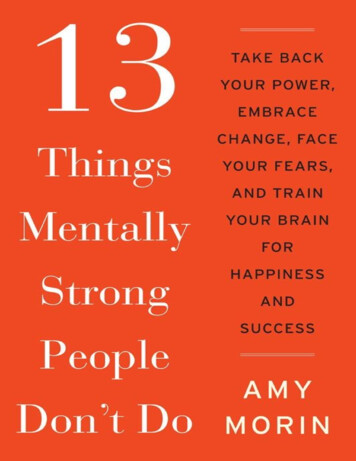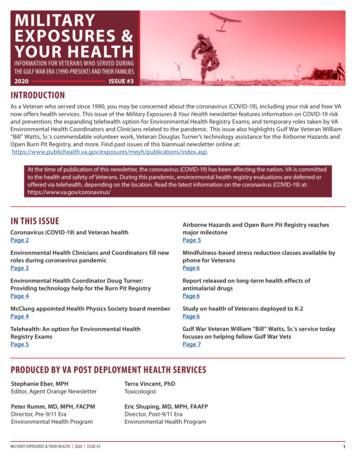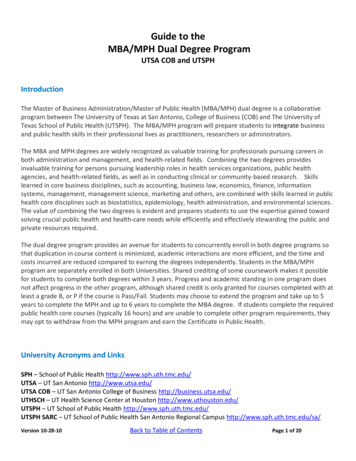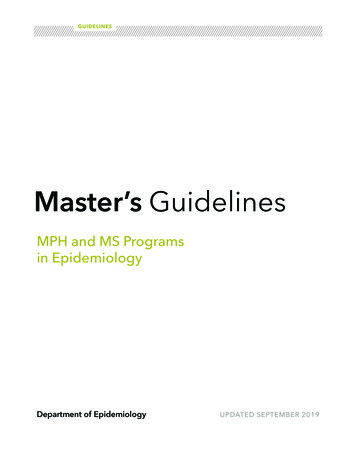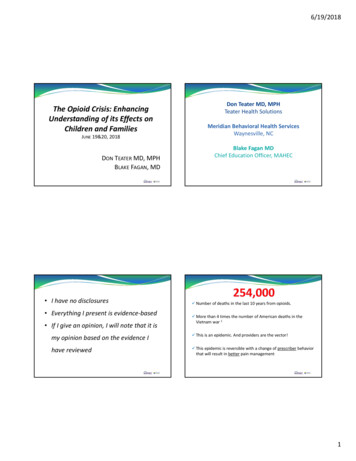
Transcription
6/19/2018The Opioid Crisis: EnhancingUnderstanding of its Effects onChildren and FamiliesJUNE 19&20, 2018DON TEATER MD, MPHBLAKE FAGAN, MD I have no disclosures Everything I present is evidence‐based If I give an opinion, I will note that it isDon Teater MD, MPHTeater Health SolutionsMeridian Behavioral Health ServicesWaynesville, NCBlake Fagan MDChief Education Officer, MAHEC Number of deaths in the last 10 years from opioids. More than 4 times the number of American deaths in theVietnam war 1my opinion based on the evidence I This is an epidemic. And providers are the vector!have reviewed This epidemic is reversible with a change of prescriber behaviorthat will result in better pain management1
6/19/2018OPIOID PRESCRIBING RATESBY COUNTY IN NORTH CAROLINA 2CONFESSIONMap courtesy NC Dept. of Health and Human Services 2017GOALS1. Describe the impact of the opioid crisis in rural NCWHAT ARE OPIOIDS(PRESCRIPTION PAINKILLERS)?3,4,5,6,7,82. Describe Medication Assisted Treatment (MAT)3. Describe the effect of opioids during pregnancy onthe neonate4. Describe the effects of opioids on the family unitCodeine Oxycodone Vicodin FentanylPowderHeroinBlack TarHeroin2
6/19/2018USA Total Opioid Consumption5OPIOID FACTS2000Pain as the 5th Vital Sign The United States has 4.6% of the world’spopulation. We use 80% of the worlds opioids!3 83% of the world’s population has no access toanyLate 1990’sIntractable Pain Actopioids.4Early 2000Aggressive Marketing1996APS/AAPMConsensus Statement1986Portenoy Foley ArticleTHE STATE OF US HEALTH79Years lived with disability (in thousands)350030002500200019901500201010005000Low back painOther MSdiseaseNeck painOsteoarthritis3
6/19/2018PRIMARY PURPOSE: Dopamine – Our primary reward system.SWITCHING GEARSThis is what we live for. Endorphins and opioid receptors – Thesemaximize our ability to achieve the rewardOPIOID RECEPTORS (WHEN YOU FIRSTSTART TAKING THEM)Enable us to achieve a goal (short term).12,13 Decrease pain. Increase motivation. Increase confidence. Increase reward.SAFE OPIOID PRESCRIBING Reduce depression and anxiety. Increase pleasure in current activity. Increase “warmth‐liking”.14 Liking warm things. Love. Interpersonal bonding.4
6/19/2018CDC GUIDELINE FOR ACUTE PAINIF you prescribe (opioids) Prescribe 3 day supply More than 7 days will rarely be required Counsel patients about safe storage and disposal ofunused opioidsNC STOP Act Went into effect January 1st, 2018 If you prescribe opioids for acute pain, initialprescription must be 5 days or lessCharacteristics of InitialPrescription Episodes andLikelihood of Long‐Term OpioidUse — United States, 2006–2015 For post‐op pain 7 days or less Must look patient up in the NC CSRS and document inyour chart that you did look them up (Delayed)5
6/19/2018.FIGURE 1. One‐ and 3‐year probabilities of continued opioid useamong opioid‐naïve patients, by number of days’ supply* of thefirst opioid prescription — United States, 2006–2015 15CHRONIC OPIOID CONSUMPTIONFIGURE 2. One‐ and 3‐year probabilities of continued opioid useamong opioid‐naïve patients, by number of prescriptions* in thefirst episode of opioid use — United States, 2006–2015 15CDC GUIDELINE FOR CHRONIC PAINIn general, DO NOT prescribe opioids as thefirst‐line treatment for chronic pain Depression Assess pain and function Consider if non‐opioid therapies are appropriate Talk to patients about treatment plan Evaluate risk of harm or misuse6
6/19/2018Chronic pain Epidemiologic studies have shown that those onchronic opioid therapy have worse quality of lifethan those with chronic pain who are not.70 The AAN recommends against using opioids forback pain, headaches, or fibromyalgia.71 A Cochrane review recommends against usingEfficacy of Opioids for Chronic Pain43Annals of Internal MedicineMartell et al. (2007): Systemic Review: Opioid treatment for chronicback pain: prevalence efficacy and association with addiction 4 studies indicated that opioids did not show reduced chronic backpain when compared with placebo or non‐opioid control Prevalence of life time substance use disorders ranged from 36% to56% Prevalence of current substance use disorders were estimated to beas high as 43%opioids for OA of the hip or knee.72Multimodal tx in chronic pain:What Works? Counseling74 CBTMindfulness Treat Mood Disorders PT, Yoga Exercise, Tai Chi Acupuncture, Massage Amitriptyline Duloxetine (and other antidepressants) Gabapentin (and other anticonvulsants)Prescription Opioids in Adolescence17According to Miech et al. (2015) Teens who received a prescription for opioidpain medication by Grade 12 were at 33percent increased risk of misusing an opioidbetween ages 19 and 25. Among those with low predicted risk of futureopioid use in 12th grade, having an opioidprescription increased their risk of post‐high‐school opioid misuse three‐fold7
6/19/2018DID YOU KNOWdrug abuse startsearly?More than 90% of adults withsubstance use disordersstarted using before age 1818Encourage Caregiversto talk to their childrenChildren who learn about thedangers of drugs at home areup to 50 percent less likely touse drugs19EFFICACY OF PAIN MEDIATIONS ACUTE PAIN34,35Percent with 50% pain relief62OPIOID ALTERNATIVES4037372821Ibuprofen 200mgAcetaminophen500 mgIbuprofen 400mgOxycodone 15mgOxy 10 acet1000Ibu 200 acet5008
6/19/2018WHY DO PEOPLEPain‐Addiction‐Mental HealthSTART ABUSING OPIOIDS? A person may: Begin to misuse meds by increasing the dose ontheir own These three conditions are all closely related and affect the same areasof the brain. These conditions often co‐occur and should be considered duringtreatment of the patient with pain. Use to cope with emotional stress or pain ortrauma Experiment with opioids as a way to get high‐ takeother people’s medicationWHY DO THEY CONTINUE? Fear of withdrawal Withdrawal undoes everything that opioid intoxication does –and when the pendulum swings back it can be very painful. What does withdrawal feeling like? The flu X 10 Cravings If a user gets through physical withdrawal they may thenexperience emotional withdrawal: missing the feeling ofbeing high. This can result in relapse, which means that auser starts using again.35RELAPSE Relapse is dangerous. Why? Loss of tolerance Because a user may go back to using thesame dosage they did prior to stopusing, but their body is not ready for it. Which leads to? Overdose and death369
6/19/2018TREATMENT OF OPIOID USEDISORDER IN ADULTSTREATMENT OF OPIOID USEDISORDER68 Detox and abstinence Detox and abstinence: Success rate 10% Methadone Methadone: Success rate 60% Buprenorphine Buprenorphine: Success rate 60% Naltrexone injection Naltrexone injection: Success rate 10‐50%3738NAS is Not AddictionSwitching Gears Newborns can’t be “born addicted” NAS is withdrawal – due to physical dependenceQuestions? Physical dependence is not addiction Addiction is brain illness whose visible signs are behaviors Newborn do not have the life duration or experience tomeet the addiction definition Addiction is chronic disease – chronic illness can’t be presentat birthSee https://tonic.vice.com/en rtesy of HE JonesJones & Fielder, PreventiveMedicine, 2015.10
6/19/2018METHADONENEONATAL ABSTINENCE SYNDROME What % of infants exposed to opiates At what methadone dose (in the mom) arewithdrawal? Not all of them Earlier Studies: 48% to 94%62 30% to 80%63clinically significant withdrawal symptomsuncommon? 20mg/day63TRUE OR FALSE The higher the maternal methadone dose,the more likely the neonate will have NAS. No correlation was found between maternalmethadone dose and rate of NAS64Courtesy of HE Jones11
6/19/2018Total Amount of Morphine Neededto Treat aSmokigengSmokingNumber of DaysMedicated for elowAverageSmoking16114.6418[2V10864Non2 0 SmokingMeanNumber ofDays6Mean BirthWeight (gm)Mean Amount ofMorphine (mg) Having the mom and baby room in together the most effective Swaddling Settling Massage Relaxation baths Pacificers Waterbeds66MOTHER: Smoking and NASMeanNumber ofDaysNON‐PHARMACOLOGICAL TREATMENTSFOR 0028003149Total Length ofHospital Stay111.79.4BeloAverawgeAveraSmokigengSmoking Neonatal Weightat ovAboe-veaverAveraagegeSmoSmokikingng Do you know about The Happiest Baby on the Block?Courtesy of HE JonesMOTHER Child Outcomes upto 36 monthsJones HE, et al. Drug Alcohol Depend.2013;131(3):271‐277.Breastfeeding Both methadone and buprenorphine are compatiblewith breastfeedingN 96 children No pattern of differences in physical or behavioraldevelopment to support medication superiority No pattern of differences for infants treated for NAS v. infantswho did not receive treatment for NAS Results indicate children born in the MOTHER study arefollowing a path of normal development in terms of growth,cognitive and psychological developmentCourtesy of HE JonesKaltenbach, K. The MOTHER study: what about the children? Presented AAAP 2015(manuscript under review) Concentration of either medication in breast milk islow Most recent guidelines: “the amounts ofbuprenorphine in human milk are small andunlikely to have negative effects on the developinginfant”Akinson et al., 1990; Marquet et al., 1997; Johnson, et al., 2001; Grimm et al., 2005; Lindemalm et al.,2009; Jansson et al., 2009; Müller et al., 2011; Reece-Stremtan, Marinelli and The Academy ofBreastfeeding Medicine. Breastfeeding Medicine, 2015.Courtesy of HE Jones12
6/19/2018Pregnancy: A Unique TreatmentOpportunitySWITCHING GEARS Mothers with substance use disorders have a mortality rate 8.4 timesthat of US women of similar age Pregnant women who use illicit substances maydelay prenatal care and miss more healthcare visitsthan women who do not use substances Prenatal care may help to reduce the negativeimpact of illicit drug use on birth outcomesHser, Kagihara, Huang, Evans, & Messina, 2012; Funai et al., 2003 Staton et al., 2003 and Wagner et al., 1998; El-Mohandes et al., 2003; Roberts and Pies,2011 and Schempf and Strobino, 2009; Chatterji and Markowitz, 2001, Clark et al., 2004, Conners et al., 2004 Hanson et al., 2006 and Linares et al., 2006Courtesy of HE JonesPregnancy: A Unique TreatmentOpportunity Lower prenatal care utilization may be due to a diverse set of barriers to seeking and obtaining care, including fear of childcustody issues After childbirth, ongoing substance usedisorders bycaregiversand the dysfunctional homeenvironment may create detrimentaleffects on children's psychologicalgrowth and development Maternal well-being has been recognized as a keydeterminant of the health of the next generationCourtesy of HE JonesMedication Assisted Treatment v. Medication‐Assisted Withdrawal WHO 2014 Guidelines: “Pregnant women dependent on opioids shouldbe encouraged to use opioid maintenance treatment whenever availablerather than to attempt opioid detoxification. Opioid maintenancetreatment in this context refers to either methadone maintenancetreatment or buprenorphine maintenance treatment.” Guidance regarding maintenance versus medication‐assisted withdrawalhas traditionally been based largely on good clinical judgment Medication followed by no medication treatment has frequently beenfound to be unsuccessful, with relatively high attrition and a rapid returnto illicit opioid useCourtesy of HE Jones13
6/19/2018Medication Assisted Treatment v. Medication‐Assisted Withdrawal Maintenance medication facilitates retention of patients and reducessubstance use compared to no medication Biggest concern with opioid agonist medication during pregnancy is thepotential for occurrence of neonatal abstinence syndrome (NAS) – atreatable conditionFAMILY DYNAMIC May be a family that has limited emotionalresources, financial resources, support Mom may have feelings of guilt, shame She is dealing with her chronic relapsingdisease May have post‐partum depressionCourtesy of HE JonesMOTHER’S MENTALWhat isRecovery?STATE67SAMHSA’s WorkingDefinition Maternal guilt and anxiety, insecurity about her ability toparent due to poor parental role modeling, the loss of otherchildren and a lack of self‐esteem are common among thispopulation of women. If in addition she lacks the ability to recognize these feelings,modulate them, and take the appropriate actions on behalf ofherself and her child, maladaptive behaviors such as relapse,aggressive behaviors with relatives or health care providers,and/or neglect of the baby may be the outcome.Recovery and Treatment are notthe same!Recovery is aprocess of changethrough whichindividuals improvetheir health andwellness, live selfdirected lives, andstrive to reach theirfull potential.Source: SAMHSA. (2016). Treatment for substance use e-use-disorders.14
6/19/2018SUMMARYSO I HOPE YOU CAN Describe the impact of the opioid crisis Describe Medication Assisted Treatment (MAT) Describe the effect of opioids during pregnancy onthe neonate Describe the effects of opioids on the family unitSECONDARY GOALS You now know to avoid opioids in kids if at allpossible You know 1 acetaminophen (500mg) and 1 Ibuprofen(200mg) is more effective pain control than 15mg ofoxycodone58REFERENCESQuestions?1.Weekman K. Drugs have killed more Americans in 4 years than WWI and WWII combined. 8/. Published April 19, 2017. AccessedNovember 28, 2017.2.Map courtesy NC Dept. of Health and Human Services 20173.Solanki DR, Koyyalagunta D, Shah R V, Silverman SM, Manchikanti L. Monitoring opioid adherence in chronic pain patients: assessment of risk ofsubstance misuse. Pain Physician. 2011;14(2):E119‐E131. http://www.ncbi.nlm.nih.gov/pubmed/21412377.4.Seya M‐J, Gelders SF a M, Achara OU, Milani B, Scholten WK. A first comparison between the consumption of and the need for opioid analgesics atcountry, regional, and global levels. J Pain Palliat Care Pharmacother. 2011;25(1):6‐18. doi:10.3109/15360288.2010.536307.5.United States of America Opioid Consumption in Morphine Equivalence (ME), mg per person. Pain & Policy Study inpolicy.wisc.edu/files/country files/morphine equivalence/unitedstatesofamerica me methadone.pdf. Published 2015. Accessed November 27, 2017.6.Pain & & Policy Study Group, American Caner Society, American Cancer Society Cancer Action Network. Achieving Balance in State Pain Policy: AProgress Report Card (CY 2015) . Carbone Cancer Center. July 2016:1.7.US Burden of Disease Collaborators. The state of US health, 1990‐2010: burden of diseases, injuries, and risk factors. JAMA. 2013 Aug14;310(6):591‐608. doi: 10.1001/jama.2013.13805. PubMed PMID: 238425778.Paulozzi LJ, Jones CM, Mack KA, Rudd RA. Vital signs: overdoses of prescription opioid pain relievers‐‐‐United States, 1999‐‐2008. MMWR MorbMortal Wkly Rep. 2011;60(43):1487‐1492. http://www.ncbi.nlm.nih.gov/pubmed/22048730.9.N.C. State Center for Health Statistics, Vital Statistics‐Deaths. Unintentional medications or drug overdose: X40‐44 with any mention of specificT‐codes by drug use. http://www.schs.state.nc.us/data/databook/. Accessed November 28th, 201710. IASP Taxonomy . IASP‐Pain. https://www.iasp‐pain.org/Taxonomy. Accessed November 27, 2017.11. Davis, B., & Vanderah, T. (2016). A new paradigm for pain? The Journal of Family Practice, 65(9), 598–605.15
6/19/2018REFERENCESREFERENCES12. Polunina AG, Bryun E a. Neuropsychological Functions of μ‐ and δ‐Opioid Systems. ISRN Addict. 2013;2013:1‐13. doi:10.1155/2013/674534.25. Edlund MJ, Martin BC, Russo JE, Devries A, Braden JB, Sullivan MD. The Role of Opioid Prescription in Incident Opioid Abuse and DependenceAmong Individuals With Chronic Noncancer Pain. Clin J Pain. 2014;30(7):557‐564.13. Inagaki TK, Ray LA, Irwin MR, Way BM, Eisenberger NI. Opioids and social bonding: Naltrexone reduces feelings of social connection. Soc CognAffect Neurosci. 2016;epub ahead:1‐8. doi:10.1093/scan/nsw006.14. 15. Schweiger D, Stemmler G, Burgdorf C, Wacker J. Opioid receptor blockade and warmth‐liking: Effects on interpersonal trust and frontalasymmetry. Soc Cogn Affect Neurosci. 2014;9(10):1608‐1615. doi:10.1093/scan/nst152.15. Shah A, Hayes CJ, Martin BC. Characteristics of Initial Prescription Episodes and Likelihood of Long‐Term Opioid Use — United States, 2006–2015. MMWR Morb Mortal Wkly Rep 2017;66:265–269.16. Martell B, O’Connor P, Kerns R, et al. Systematic review: opioid treatment for chronic back pain: prevalence, efficacy, and association withaddiction. Ann Intern Med. 2007;146(2):116‐127. http://annals.org/article.aspx?articleid 732048. Accessed August 9, 2014.17. Miech R, Johnston L, O'Malley P, Keyes K, Heard K. Prescription opioids in adolescence and future opioid misuse. Pediatrics. 2015;136:e1‐e9.doi:10.1542/peds.2015‐1364.18. CASAColumbia. (2011). Adolescent Substance Use : America’s #1 Public Health Problem. Retrieved erica’s‐1‐public‐health‐problem19. SAMHSA: Talking to your kids about prescription drug abuse. SMA‐12‐4676B120. Cherrier MM, Amory JK, Ersek M, Risler L, Shen DD. Comparative cognitive and subjective side effects of immediate‐release oxycodone in healthymiddle‐aged and older adults. J Pain. 2009;10(10):1038‐1050. doi:10.1016/j.jpain.2009.03.017.21. Gooch CM, Rakitin BC, Cooper ZD, Comer SD, Balsam PD. Oxycodone lengthens reproductions of suprasecond time intervals in human researchvolunteers. Behav Pharmacol. 2011;22(4):354‐361. doi:10.1097/FBP.0b013e328348d8b8.22. Thiele RH, Rea KM, Turrentine FE, et al. Standardization of Care: Impact of an Enhanced Recovery Protocol on Length of Stay, Complications, andDirect Costs after Colorectal Surgery. J Am Coll Surg. 2015;220(4):430‐443. doi:10.1016/j.jamcollsurg.2014.12.042.26. Chu LF, Clark DJ, Angst MS. Opioid tolerance and hyperalgesia in chronic pain patients after one month of oral morphine therapy: a preliminaryprospective study. J Pain. 2006;7(1):43‐48. doi:10.1016/j.jpain.2005.08.001.27. Webster BS, Verma SK, Gatchel RJ. Relationship between early opioid prescribing for acute occupational low back pain and disability duration,medical costs, subsequent surgery and late opioid use. Spine (Phila Pa 1976). 2007;32(19):2127‐2132. doi:10.1097/BRS.0b013e318145a731.28. Miller M, Stu ÃT, Azrael D. Opioid Analgesics and the Risk of Fractures in Older Adults with Arthritis. J Am Geriatr Soc. 3318.x.29. Ray WA, Chung CP, Murray KT, et al. Prescription of Long‐Acting Opioids and Mortality in Patients With Chronic Noncancer Pain. JAMA.2016;315(22):2415. doi:10.1001/jama.2016.7789.30. Dowell D, Haegerich TM, Chou R. CDC Guideline for Prescribing Opioids for Chronic Pain — United States, 2016. MMWR. 2016;65.doi:10.1001/jama.2016.1464.31. Tenore PL. Psychotherapeutic benefits of opioid agonist therapy. J Addict Dis. 2008;27(3):49‐65. doi:10.1080/10550880802122646.32. Younger JW, Chu LF, D’Arcy NT, Trott KE, Jastrzab LE, Mackey SC. Prescription opioid analgesics rapidly change the human brain. Pain.2011;152(8):1803‐1810. doi:10.1016/j.pain.2011.03.028.33. Odgers CL, Caspi A, Nagin DS, et al. Is it important to prevent early exposure to drugs and alcohol among adolescents? Psychol Sci.2008;19(10):1037‐1044. doi:10.1111/j.1467‐9280.2008.02196.x.34. Teater D. Evidence for the Efficacy of Pain Medications. Itasca, Illinois; 2014. www.nsc.org/painmedevidence.35. Moore RA, Derry S, McQuay HJ, Wiffen PJ. Single dose oral analgesics for acute postoperative pain in adults. Cochrane Database Syst Rev.2011;9(9):CD008659. doi:10.1002/14651858.CD008659.pub2.23. Woller S a., Hook M a. Opioid administration following spinal cord injury: Implications for pain and locomotor recovery. Exp Neurol.2013;247:328‐341. doi:10.1016/j.expneurol.2013.03.008.24. White J a, Tao X, Talreja M, Tower J, Bernacki E. The effect of opioid use on workers’ compensation claim cost in the State of Michigan. J OccupEnviron Med. 2012;54(8):948‐953. doi:10.1097/JOM.0b013e318252249b.REFERENCES36. Chang A, Bijur P, Esses D, Barnaby D, Baer J. Effect of a single dose of oral opioid and nonopioid analgesics on acute extremity pain in theemergency department: a randomized clinical trial. JAMA. 2017;318(17):1661‐1667. doi:10.1001/jama.2017.16190.37. Holdgate A, Pollock T. Nonsteroidal anti‐inflammatory drugs (NSAIDS) versus opioid for acute renal colic . Cochrane Database System Reviews .2005;18(2). doi:10.1002/14651858.CD004137.pub3.38. Thiele, R. H., Rea, K. M., Turrentine, F. E., Friel, C. M., Hassinger, T. E., Goudreau, B. J., McMurry, T. L. (2015). Standardization of Care: Impact ofan Enhanced Recovery Protocol on Length of Stay, Complications, and Direct Costs after Colorectal Surgery. Journal of the American College ofSurgeons, 220(4), 430–443. . Rodgers J, Cunningham K, Fitzgerald K, Finnerty E. Opioid consumption following outpatient upper extremity surgery. Journal of Hand Surgery.2012;37(4):645‐650. doi:10.1016/j.jhsa.2012.01.035.40. Zachary SS, Danesh H. Acupuncture in the Management of Chronic Pain. Topics in Pain Management. 938.92.41. Shanmugam V, Fernandez S, Evans K, et al. Postoperative wound dehiscence: predictors and associations. Wound Repair and Regeneration .2015;23(2):184‐190. doi:10.1111/wrr.12268.42. Miller M, Sturmer T, Azrael D, Levin R, Solomon D. Opioid Analgesics and the Risk of Fractures Among Older Adults with Arthritis. Journal of theAmerican Geriatrics Society. 2011;59(3):430‐438. doi:10.1111/j.1532‐5415.2011.03318.x.43. Pulver A, Davison C, Parpia A, Purkey E, Pickett W. Nonmedical Use of Prescription Opioids and Injury Risk Among Youth. Journal of Child &Adolescent Substance Abuse. June 2016:522‐529. doi:10.1080/1067828X.2015.1115795.44. Kotecha M, Sites B. Pain policy and abuse of prescription opioids in the USA: a cautionary tale for Europe. Journal of the Association ofAnesthetists of Great Britain and Ireland. November 2013:1210‐1215. doi:10.1111/anae.12450.45. Kidner C, Mayer T, Gatchel R. Higher opioid doses predict poorer functional outcome in patients with chronic disabling occupationalmusculoskeletal disorders. Journal of Bone and Joint Surgery. 2009;91(4):919‐927. doi:10.2106/JBJS.H.0028616
Do you know about The Happiest Baby on the Block? 2.5 1.8 6. 1 7 6 5 4 3 2 1 0 Non-Smoki ng Belo w-Avera ge Smoki ng Avera ge Smoki ng Abov e-Avera ge ng Mean Amount of Morphine (mg) Total Amount of Morphine Needed to TreatNAS 4. 2 5. 2 7[V 0 8 6 4 2 10 9.5 Non-Smoki ng Belo w-Avera ge
